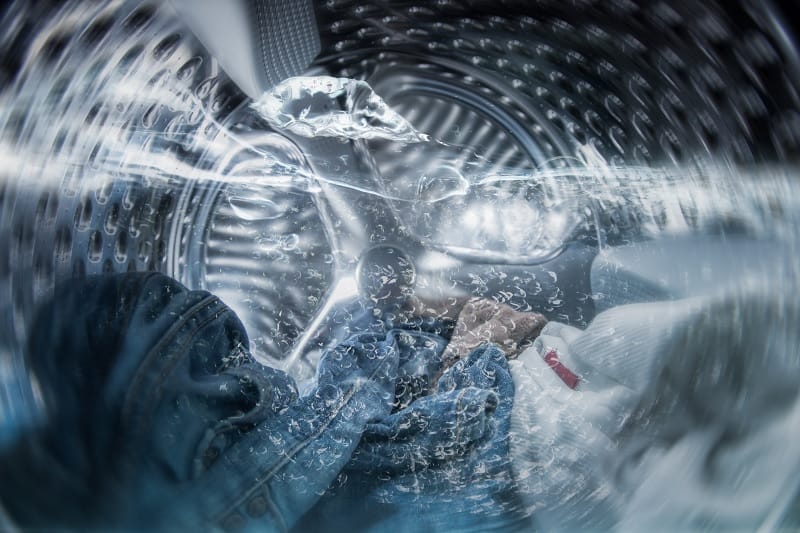The term “deep water wash” often surfaces as a setting on top-loading washing machines, providing an extra layer of cleaning prowess. But what exactly is a deep water wash, and when should you opt for this feature?
What Does “Deep Water Wash” Mean?
The deep water cycle is precisely as its name suggests. By selecting the “deep water wash” on your washing machine, you’re selecting a program that uses more water during the washing cycle.
This setting is designed for washing larger loads of laundry or heavily soiled items that may require more water for effective cleaning.
The deep water wash option ensures that there is enough water to thoroughly soak and agitate the clothes, helping to remove dirt and stains more effectively.
While great for improved cleaning, deep water washes shouldn’t be used as a standard for one main reason: the cost of running your washing machine.
Using more water may result in higher water consumption, so it’s advisable to use this setting only when necessary.
Note: Always refer to your user manual for specific details about the features of the deep water wash on your appliance. Manufacturers may use different terminology, and the functions can vary based on the make and model of the washer.
When Should You Use a Deep Water Wash?
You may consider using a deep water wash in the following situations:
- When washing a larger-than-usual mixed load that might not be effectively cleaned or submerged with the standard water level.
- For items with heavy, dried-on stains or dirt that require more water for thorough cleaning. This includes towels and household linens that can accumulate dirt and germs.
- When washing bulky items like blankets, comforters, or large bedding that may benefit from a higher water level to ensure proper cleaning and rinsing.
- For washing sturdy fabrics that can withstand a more vigorous washing process, such as jeans and denim jackets.
- If you have time for a longer washing cycle, as deep water washes take more time than other cycles—especially compared to standard quick-wash machines.
Keep in mind that using a deep water wash setting typically consumes more water, so you should only use it for specific loads.
For everyday washing with regular soil, a normal wash cycle with the standard water level is usually sufficient.
What Is the Difference Between Deep Wash and Normal Wash?
The main difference between a “deep wash” and a “normal wash” is the water level. Deep washes typically use a higher water level, whereas a normal wash uses a standard water level suitable for regular loads with moderate soil.
However, there are also a few more differences to consider that can help you decide the best cycle for removing stains and dirt from fabrics:
- Agitation: Deep water washes may involve more aggressive or longer agitation cycles to help remove tough stains and dirt from larger or heavily soiled loads. Regular washes use a standard agitation level suitable for everyday laundry and less sturdy fabrics.
- Cycle duration: Deep washes might be longer to accommodate the need for additional water and more intensive cleaning, taking anywhere from 1 to 2 hours. In comparison, regular washes have a shorter cycle duration of around 60 minutes, suitable for regular laundry.
- Energy and water efficiency: As they use a deeper water level, deep washes typically use more water. They also may consume more energy due to the extended washing process. Normal wash programs are designed to be more efficient for everyday laundry needs.
- Intended load size: Deep washes are specifically suited for larger loads or items with heavy soil, whereas regular washes are for standard-sized loads with moderate soil. Be careful not to overload the machine, though—even large loads should have enough space to move.
What’s the Difference Between Deep Water Wash vs. Power Wash?
Some washing machine brands have an additional “power wash” cycle as one of their speciality settings.
This program can easily get confused with deep water washes, as they are both designed to launder heavily soiled items more effectively than a regular wash.
However, there are a few distinctions between both cycle types. Understanding these differences can help you choose the correct program for your garments and linens:
- Cleaning power: The term “power wash” suggests a more intensive cleaning process that usually involves increased water pressure, stronger agitation, and hotter water. In comparison, deep water washes generally use more water to achieve a powerful clean.
- Load size: Power wash settings are designed to tackle stubborn stains and heavily soiled items without using excess water, so they can be used for normal-sized loads. Meanwhile, deep water wash cycles are better suited for bigger and bulkier loads of laundry.
- Type of washing machine: Power wash programs are typically available in front loaders and top loaders. However, only top-loading washing machines tend to have deep enough drums to offer deep water wash programs.
What’s the Difference Between Deep Water Wash and Auto Sensing?
Many modern washing machines have an auto-sensing water level adjustment. When you select this setting, the washer automatically detects the size of the load and adjusts the water level accordingly.
Therefore, both deep water washes and auto-sensing settings help washers clean clothes more effectively by adjusting the water level.
However, there are a few subtle differences between these two speciality wash cycle settings:
- User control: Deep water wash programs give you control over selecting a higher water level, while auto-sensing relies on sensors to automatically determine the appropriate water level based on the load size.
- Flexibility: Deep water washes allow manual customisation for added flexibility. This is great if you’re washing heavily soiled clothes that the auto-sensor might not detect. On the other hand, auto-sensing aims to automate the process for convenience and efficiency.
- Water efficiency: Auto-sensing can lead to increased energy and water efficiency compared to fixed water level settings, like a deep water wash. It tailors the water level to the specific load, potentially reducing water consumption.

Hannah has a passion for cleaning. She worked her way around Australia by cleaning hostels in exchange for free accommodation and used her cleaning skills to bag a job as a chalet host for a luxury ski company in France.






